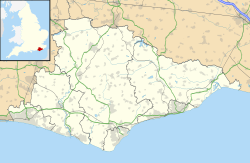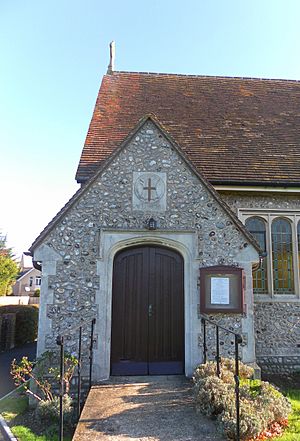St George's Church, Polegate facts for kids
Quick facts for kids St George's Church |
|
|---|---|

The church from the west-northwest in 2023
|
|
| 50°49′08″N 0°14′34″E / 50.8188°N 0.2428°E | |
| Location | Eastbourne Road, Polegate, East Sussex BN26 5DF |
| Country | England |
| Denomination | Roman Catholic |
| Website | saintsgeorgeandwilfrid.co.uk |
| History | |
| Status | Church |
| Founded | 7 June 1938 |
| Founder(s) | Fr. John Corballis of Our Lady of Ransom Church, Eastbourne |
| Dedication | Saint George |
| Architecture | |
| Functional status | Active |
| Architect(s) | J. O'Hanlon Hughes and Geoffrey Webb |
| Style | Perpendicular Gothic Revival |
| Groundbreaking | 7 June 1938 |
| Completed | 7 December 1938 |
| Construction cost | £4,000 (construction) £500 (fixtures and fittings) £1,318 (land and legal fees) (Contractor W. Llewellyn & Sons) |
| Administration | |
| Parish | Hailsham and Polegate |
| Deanery | Eastbourne |
| Diocese | Arundel and Brighton |
St George's Church is a Roman Catholic church located in Polegate, a town in East Sussex, England. It serves the local community as part of the Hailsham and Polegate parish.
People first thought about building a Catholic church in Polegate in the late 1800s. At that time, Polegate was a small but growing village. It was part of a much larger church area based in Eastbourne. A new priest arrived in Eastbourne in 1936, and things started to happen. Within two years, construction began. By the end of 1938, the church, built in a Gothic Revival style with flint and stone, was open. After World War II, the church had some problems with its structure. Money was spent on other churches in the area, so repairs at St George's had to wait until the 1950s and 1960s.
St George's Church has changed its parish structure five times over the years. It started as a small church connected to the Eastbourne parish. In 1958, it became a separate area within Eastbourne with its own priest. Two years later, in 1960, it became fully independent when the new parish of Polegate with Hampden Park was created. Five years after that, Polegate and Hampden Park separated. However, they later joined again before another change in the early 2000s created the current joint parish of Hailsham and Polegate. The church holds weekly services and is also a place where marriages can officially take place.
Contents
History of St George's Church
Polegate was once a small village. It grew very quickly in the 1800s and early 1900s. This happened because the London, Brighton and South Coast Railway built two train lines that met there. In 1873, there were only 50 houses. By the early 2000s, over 8,000 people lived there. The town also grew closer to its larger neighbor, Eastbourne.
The main Catholic church in Eastbourne, Our Lady of Ransom Church, served Polegate. In 1895, the priest of that church told his bishop that people in distant villages, including Polegate, needed a local place for Mass. Polegate was about 5 miles (8 km) from Eastbourne. The priest said there were nine Catholic families who would benefit from a church closer to home. Around the same time, a man named William Attwood died. He had a private prayer room in his house, which might have been used for public services, but we don't know for sure.
Nothing much happened until 1913. Then, another person allowed their house in the Hampden Park area (near Polegate) to be used for worship. This became a regular monthly Mass starting in May 1919.
Building the Church
Father John Corballis became the priest of Our Lady of Ransom Church in January 1936. He immediately wanted to build a church in Polegate. The next month, he bought a piece of land for £1,318.10s.10d. This land was at the corner of Polegate crossroads, where the High Street meets the main road to Eastbourne. Money was raised to pay off this debt.
Building work was planned to start in the summer of 1938. An architect was hired to design the new church. On June 7, 1938, Bishop William Francis Brown led a special service to lay the foundation stone. The building work took exactly six months. On December 7, 1938, Bishop Peter Amigo and other priests attended the first Mass in the new church. It was named after Saint George. The church cost £4,000 to build, and the inside fittings cost another £500.
Early Years and Challenges
At first, there was one Mass on Saturday evening and one on Sunday morning. This continued while St George's was a smaller church connected to Our Lady of Ransom. Special religious pictures called Stations of the Cross were put up in March 1939.
During World War II, many children were moved to the Eastbourne area for safety. This meant many more people attended the churches. St George's Church was often "full" each week. Later in the war, as people left and bombing raids made the town dangerous, services at some churches were reduced or stopped. However, St George's remained open.
After the war, attention turned to building a larger church in Hailsham. They also bought land for a future church in Hampden Park. The large Eastbourne parish needed to be reorganized. Canon John Curtin became the priest of Our Lady of Ransom Church in January 1956. He decided to make several of the smaller churches, including Polegate, independent. He noted that this was what the people had wanted for many years.
This change happened in two steps. In July 1958, Father John Flanagan became the first priest for Polegate with Hampden Park. However, it was still part of the Eastbourne parish at first. St George's Church officially became separate from Eastbourne in June 1960. This happened when St Joachim's Church opened in Hampden Park, and the new parish of Polegate with Hampden Park was officially created. Before St Joachim's opened, people from Hampden Park went to St Gregory's Church in Eastbourne or to St George's. Later, from August 1958, Mass was held in a public hall and then in an old house where St Joachim's was eventually built.
Meanwhile, as early as 1952, St George's Church was found to be sinking a bit. When Canon Curtin took over, the altar and most of the seats had to be removed. They were damaged by dry rot and woodworm. The church also had no heating, and the walls and floor were rough cement. The ground was wet, causing dampness in the building. Our Lady of Ransom Church paid for some improvements. In 1965, more major work was done, costing £20,000.
Parish Changes Over Time
In September 1965, St George's parish changed for the third time. St Joachim's Church in Hampden Park got its own parish and a new priest. Father Flanagan, who had been in charge of St George's since 1958, was now only responsible for Polegate.
St Joachim's Church joined with St George's Church again in 1999. But after more changes in the early 2000s, the churches separated. A new joint parish was then formed, covering Hailsham and Polegate. By 2005, priests from St Wilfrid's Church in Hailsham served St George's. By 2007, Hampden Park was served by the Church of Christ the King at Langney.
Church Design and Style
St George's Church was built by W. Llewellyn & Sons. It was designed by J. O'Hanlon Hughes and Geoffrey Webb. These architects had also worked together in 1935 on St Thomas More Church in nearby Seaford. There, the main part of the church, the altar area, and a side aisle they designed are still standing today. Geoffrey Webb also designed a stained glass window at Roedean School and a sculpture in St Dunstan's Church, Mayfield.
The church is a simple building. It is built in the Perpendicular Gothic Revival style. It is a long rectangle with no side sections or chapels. It has a single roof that slopes down on two sides. There is a side porch that sticks out a bit from the front wall. The walls are made of local flint stone with Portland stone details. The windows on the side walls are grouped in fours and have slightly arched tops. The windows on the front and back walls are taller and have more detailed patterns. The overall look is "Gothic, but only just." The inside is also simple, with a ceiling that slopes inwards. At the opening ceremony, Father Corballis said the design was "not fancy" but "fit in well with the surrounding downland" and was "plain … but very dignified."
Church Services and Management
St George's Church is officially registered for worship. It also has permission to hold marriages, which it received on February 26, 1940.
St George's Church is part of the Hailsham and Polegate parish. It is served by priests from St Wilfrid's Church in Hailsham. This parish is one of four that make up the Eastbourne Deanery. The Eastbourne Deanery is one of 13 deaneries in the Roman Catholic Diocese of Arundel and Brighton.
As of 2019, the Hailsham and Polegate parish has one priest. He celebrates Mass at 9:00 am on Sundays at St George's. He also offers the Sacrament of Penance (confession) once a month. At St Wilfrid's, he offers two Masses and the Sacrament of Penance weekly. St George's is one of four places of worship in Polegate. The others are Anglican, United Reformed, and Seventh-day Adventist churches.
In 2005–2006, the Diocese of Arundel and Brighton looked at how many people attended its churches, how much space they had, and how the parishes were set up. They reported that one priest served the Hailsham and Polegate parish. One Sunday Mass was held at St George's Church. The average number of people attending was 88. The church could seat 100 people. However, a report from the opening service in 1938 said it could hold 120 worshippers.
See also



